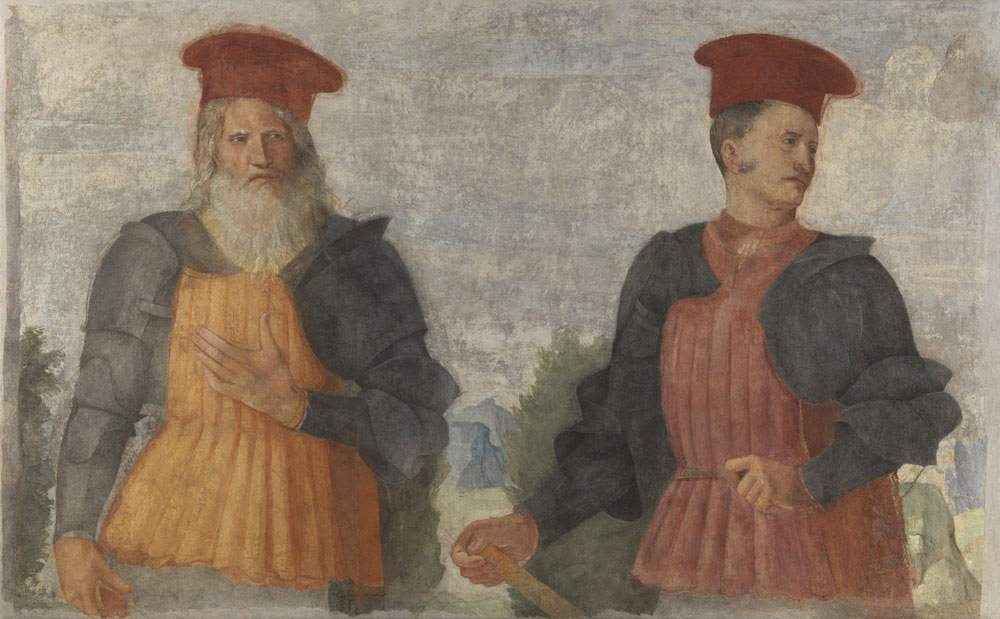The restoration of the Gallery of the House of the Podestà in Lonato del Garda (Brescia), among the most valuable house museums in northern Italy, has revealed that the three monumental fresco tears on the walls are by Girolamo Romanino (Brescia, c. 1484 - c. 1566), the most original painter of the 16th-century Brescian school. These depict captains of fortune; purchased by Ugo Da Como in the 1920s, they had been attributed to Brescian painter Floriano Ferramola: now they are confirmed to be early works by Girolamo Romanino.
The attribution, which confirms what scholars had long believed, was made possible thanks to restoration work on the Gallery and what it holds: the restorations were accomplished thanks to the sponsorship of the Green Up Company, which fully financed them. A leading company in the integrated management of environmental services, GreenUp is one of the members of the Club della Rocca, a group of patrons called together by the Fondazione Ugo Da Como (a nonprofit cultural organization established in 1942, which heads the Monumental Complex comprising the Visconti-Venetian Fortress, the House Museum and Library of Senator Da Como, the park, and the gardens) in order to provide for the numerous conservation works that the historic buildings and the vast artistic, archival and book collections require.
The Gallery constitutes the large entrance vestibule(and one of the most representative rooms) of the so-called “Casa del Podestà,” home of Senator Ugo Da Como, now a House Museum recognized by the Lombardy Region and open to the public. The guided tour gives the opportunity to admire more than twenty rooms fully furnished, according to the dictates of the taste of the upper middle class between the 19th and 20th centuries. Inside the antique furniture, the Gallery preserves 850 printed volumes, part of the 50,000 titles that make the Ugo Da Como Foundation Library one of the most important, private ones in northern Italy.
On the walls stand out more than seventy coats of arms of the most important Brescian families that gave a podesta to Lonato between the 15th and all of the 16th century. Before being the home of Senator Ugo Da Como, this building was the seat of the representative of the Republic of Venice over these mainland territories. The Podesteria of Lonato played a very important role historically, and Ugo Da Como, restoring the ancient building in the early twentieth century, wanted to commemorate the history, not only by having the ancient coats of arms in the Gallery restored, but also by commissioning many others, to complete the heraldic series that represented the Lonato podestas ino the sixteenth century.
Of great interest in this large restoration site was the conservative recovery of three large fresco tears purchased by Ugo Da Como in the 1920s hitherto attributed to the Brescian painter Floriano Ferramola: now instead recognized as the first ones datable with certainty within Romanino’s catalog, they date from 1508-1509 and belong to a very well-known cycle in Brescian art, namely the one executed for the Orsini Castle in Ghedi (Bs). The elements that belonged to this decorative cycle were entirely torn from the original walls in the 19th century, sold on the antiques market, and today divided among the museums of Budapest, the Pinacoteca Civica Tosio Martinengo in Brescia, and the House of Ugo Da Como.
The frescoes can now be seen in the Gallery after careful restoration work entrusted to Luisa Marchetti; the decorations on the Gallery walls, on the other hand, were restored by Carla Valzelli and Annalisa Belloni. The Gallery’s books were also restored and entrusted to the care of Laura Chignoli’s Studio Carta. Pictorial restorations were joined by those of the fixtures and all the wooden furnishings (which were taken care of by the Bandera School of Restoration of Barbarano di Salò), a new lighting system (Alberto Zecchini, Brescia), and the conservative cleaning of the room’s terracotta floor (Alessandro Belotti). All restoration and maintenance operations were supervised by the Soprintendenza Archeologia, Belle Arti e Paesaggio for the Provinces of Bergamo and Brescia.
The restoration was also an opportunity to subject the figure of collector Ugo Da Como to new studies and verify the exact nature of what the Gallery holds. The results of the research will be reported in a monographic publication in the series I Quaderni della Fondazione. Periodical of the Friends of the Ugo Da Como Foundation Association.
Among the novelties of the Ugo Da Como Foundation is the immersive room open to the Rocca (among the largest and most powerful fortifications in Lombardy, a National Monument since 1912): visitors will be immersed in 360 degrees among images of the Castle, the House of the Podestà and the nearby municipalities of lower Garda and the Mantuan hills. Virtual tours of the entire complex with Artglass glasses will involve visitors in a journey through time and space, letting them discover the history of Ugo Da Como’s collections in the Casa del Podestà, daily life in the Rocca at the time of Isabella d’Este Gonzaga, with 3D reconstructions of some particular places in the castle, and the most peculiar specimens of the Ornithological Museum housed in the Rocca.
For more info: www.roccadilonato.it
Image: Girolamo Romanino, Men at Arms of the House of Orsini (1508-1509)
 |
| The frescoes in the Casa del Podestà in Lonato del Garda are by Romanino. |
Warning: the translation into English of the original Italian article was created using automatic tools. We undertake to review all articles, but we do not guarantee the total absence of inaccuracies in the translation due to the program. You can find the original by clicking on the ITA button. If you find any mistake,please contact us.